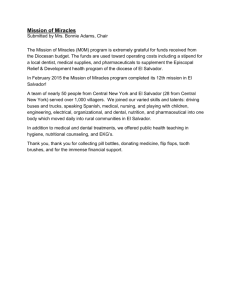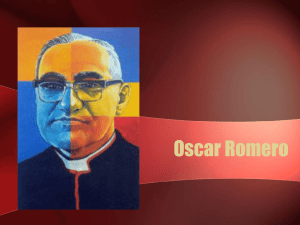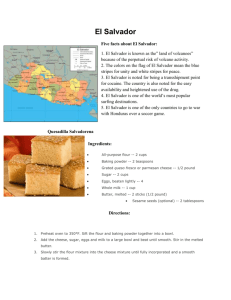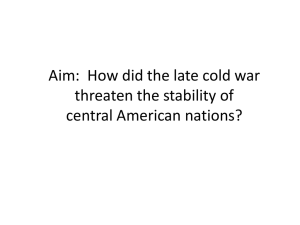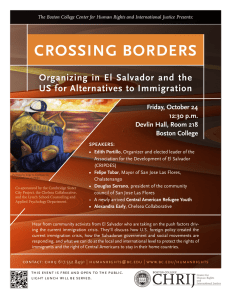Nica Times Xavier Students Travel to El Salvador
advertisement
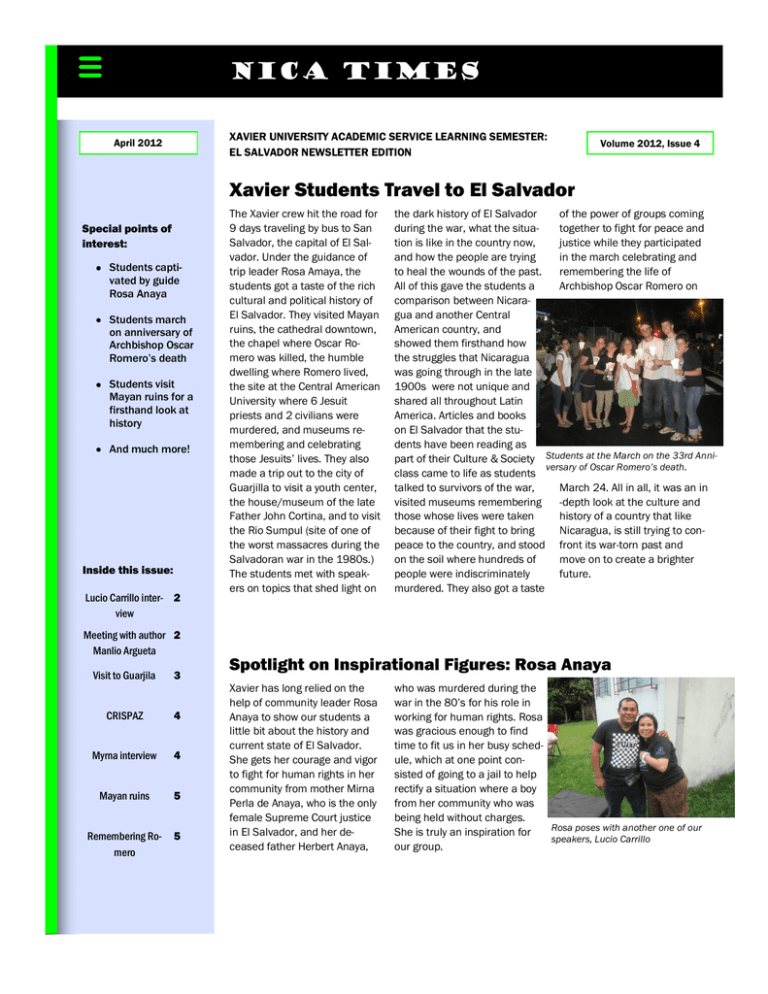
Nica Times XAVIER UNIVERSITY ACADEMIC SERVICE LEARNING SEMESTER: EL SALVADOR NEWSLETTER EDITION April 2012 Volume 2012, Issue 4 Xavier Students Travel to El Salvador Special points of interest: Students captivated by guide Rosa Anaya Students march on anniversary of Archbishop Oscar Romero’s death Students visit Mayan ruins for a firsthand look at history And much more! Inside this issue: Lucio Carrillo inter- 2 view Meeting with author 2 Manlio Argueta Visit to Guarjila 3 CRISPAZ 4 Myrna interview 4 Mayan ruins 5 Remembering Romero 5 The Xavier crew hit the road for 9 days traveling by bus to San Salvador, the capital of El Salvador. Under the guidance of trip leader Rosa Amaya, the students got a taste of the rich cultural and political history of El Salvador. They visited Mayan ruins, the cathedral downtown, the chapel where Oscar Romero was killed, the humble dwelling where Romero lived, the site at the Central American University where 6 Jesuit priests and 2 civilians were murdered, and museums remembering and celebrating those Jesuits’ lives. They also made a trip out to the city of Guarjilla to visit a youth center, the house/museum of the late Father John Cortina, and to visit the Rio Sumpul (site of one of the worst massacres during the Salvadoran war in the 1980s.) The students met with speakers on topics that shed light on the dark history of El Salvador of the power of groups coming during the war, what the situatogether to fight for peace and tion is like in the country now, justice while they participated and how the people are trying in the march celebrating and to heal the wounds of the past. remembering the life of All of this gave the students a Archbishop Oscar Romero on comparison between Nicaragua and another Central American country, and showed them firsthand how the struggles that Nicaragua was going through in the late 1900s were not unique and shared all throughout Latin America. Articles and books on El Salvador that the students have been reading as part of their Culture & Society Students at the March on the 33rd Anniversary of Oscar Romero’s death. class came to life as students talked to survivors of the war, March 24. All in all, it was an in visited museums remembering -depth look at the culture and those whose lives were taken history of a country that like because of their fight to bring Nicaragua, is still trying to conpeace to the country, and stood front its war-torn past and on the soil where hundreds of move on to create a brighter people were indiscriminately future. murdered. They also got a taste Spotlight on Inspirational Figures: Rosa Anaya Xavier has long relied on the help of community leader Rosa Anaya to show our students a little bit about the history and current state of El Salvador. She gets her courage and vigor to fight for human rights in her community from mother Mirna Perla de Anaya, who is the only female Supreme Court justice in El Salvador, and her deceased father Herbert Anaya, who was murdered during the war in the 80’s for his role in working for human rights. Rosa was gracious enough to find time to fit us in her busy schedule, which at one point consisted of going to a jail to help rectify a situation where a boy from her community who was being held without charges. Rosa poses with another one of our She is truly an inspiration for speakers, Lucio Carrillo our group. Page 2 Nica Times Lucio Carrillo: A Child of War Madeline showing off the flimsy seats at the bus station before departing back to Managua. “Lucio kept on telling us to remember that his story was simply just one of many in the war.” One of our first speakers was a thirty five year old man named Lucio Carrillo who was born in 1977 in the San Vicente department in the central part of El Salvador. His story is important to share because it is an example of the true reality of war. His memory starts at age 3. One morning green clad men, soldiers, came up to his door asking for his dad. Lucio’s Dad was not there, but up in the mountains so they took his mom and killed her. Lucio in a somber tone stated, “ From that day on I knew what a war meant.” His brother stayed behind with his grandmother and Lucio went to the mountains. The older brother thought the Army would never kill a grandmother but his grandmother and brother were killed by the National Guard. The Guardsmen let his brother die slowly little by little. Lucio has told this story many times now, yet you can still see him cringe when he tells this part. Lucio was in the mountains with his father for 5 years when one day his Dad went on a scouting trip and within a few moments an explosion. Lucio usually had always been by his father’s side but his father told Lucio to stay back at camp. Lucio’s Dad was pronounced dead and Lucio Group photo with Lucio, pictured in the black checkered was alone shirt. in the world. Lucio stated, “It was the find their lost family members hardest day of my life. I saw my because of the war. Lucio father die in my hands. All that found his two sisters and was was left for me. My Dad told me so thankful he joined Proto study and be a good boy in Búsqueda to help others. For his final words. And to leave the three years he put in 100% conflict zone.” effort for the cause some peoIf only we could tell ple ended up finding their famthe entire story in detail, but ily members. Lucio ended up being pulled Lucio kept on telling us to reout of the mountains after two member that his story was simmonths and bouncing around ply just one of many in the war. from orphanage to orphanage, At first this was hard for us to some with okay conditions, and believe, but as we kept on other orphanages looking more meeting more and more people like prisons. He eventually in El Salvador we started to came to Pro-Búsqueda an orrealize the truth in this. ganization helping people to One day of fun with author of One Day of Life The group meets Guadalupe Fuentes and with the mothers of family who were killed or disappeared during the war. Students got to meet with Manlio Argueta, author of the fictional novel One Day of Life, which takes place in El Salvador. The students read the novel as part of their Theology and Culture & Society curriculum, traveled to the city where the book was based, and were able to ask the author questions about why and how he wrote it. He excitedly told the students how many prizes he won for the book and how many languages it was translated into. He also told us about the inspiration for the book, which came out of an interview he did with Guadalupe (Lupe) Fuentes. Argueta based the main character Lupe on the stories she told him in their interview. groups for women affected by the war. She speaks at confer- After the talk with Manlio, Irene set up a meeting with Lupe to ask her questions about her life and connections to the book. Surprisingly, we found out that Manlio did not tell her that he used her story for his book, and she only found out Group photo with Manlio Argueta about it years later at a conference and did not ences and with small groups benefit financially in any way like ours to share her story with from it. To deal with losing others. loved ones lost in the war, she regularly participates in support Page 3 Volume 2012, Issue 4 Hockey in El Salvador??? On March 21st our group loaded in the bus and headed up to the town of Guarjila, up in the mountains near the Honduran border. It’s a town about one hour and a half outside of San Salvador, and a repatriated community. It is called repatriated because in 1986 the people were forced to go to refugee camps because there communities were being burned and destroyed by the National Army. The conditions were awful in the refugee camps and the people started the community of Guarjila in 1987. Right around that time an Italian man from New York named John Guiliano came to El Salvador. You might be asking why, but it’s hard to explain. John is just one of those people that when everyone else was running away from danger he went in. John was involved in the war, and remained involved after too. John saw a need in the community for recreation and in an old abandoned chicken coup built a Rec Center. In the second chicken coup right across from it built a hockey rink. Why hockey? John was a college hockey player at Columbia, and went on to play in the minors until an injury sidelined him. He saw that the kids of Guarjila needed a positive outlet, and sports were one of the possible positive outlets. John described Guarilla by saying, “it’s a lawless place with lots of @#$#ing drugs, alcohol, gang violence, rape, and more bad @#$#!” John doesn’t hold anything back from you and is a straight shooter . He tells you the truth. John is proud of his programs and prides them on the values of discipline and responsibility. He hates charity because in the refugee camps people just stood in line and were handed things, but with John that is unacceptable. Every Friday night the youth have a meeting they can’t be late. Another requirement is Sunday morning community service at 6:30 a.m. If you follow the rules the “Tamarindo”, the community center , is all yours. John is proud of the Tamarindo and especially his championship in-line hockey team. In the words of John, “ No one in Central America can hang with us we kicked John explaining the tragic history of the Costa Rica’s @#$ in the massacre at the Rio Sumpul. In one of the championship. But we are worst massacres in El Salvador, citizens humble we shake hands and trying to flee the war were gunned down wait until we get two blocks in the river by both Honduran troops tryaway from the rink to celeing to keep them out of their country and brate!” Salvadoran troops trying to exterminate John was a pleasall perceived opposition. John explains the Work Plan at El ure to be around he is high energy and passionate about Tamarindo, taken straight from what he does. He never really the prayer of St. Francis: Lord made a decision to stay and made me an instrument of your live in Guarjila but said, “ peace... those that came for lunch, “ When @*$# are still here.” He has begoes down, come like a father figure to the help John’s cause so be looking boys on his hockey team, and for that next fall. I will end with you help the they helped show us around these word from John, “ When people. And in town. We got a tour of the old @*$# goes down, you help the home of the famous priest in people. And in life you somelife you their town Jon Cortina, who times got to walk in the @#$# a sometimes you lived amongst the people suplittle bit.” Classic words from a porting them through their man who has lived his life workgot to walk in struggle during the war. Jon ing with the people of Guarjila, the @#$# a Cortina S.J was a role model for El Salvador. John Guiliano. We also visited little bit.” Rio Sumpul, it is the site of one - John Guiliano of the worst massacres during the war. That we read about in a history article and discussed in our history class. Both the Salvadorian Army and Honduran armies opened fire killing women and children. It was tough to enjoy swimming in this river with the historical implications, but we tried our best to have fun. Before I forget, John Guiliano, will be doing a bike tour across the United States next fall. (No Big Deal at all according to John). Our group will be in contact with him, and he is going to make a stop at Xavier. He is raising money to build a new sports complex. We Local celebrity: A group of Salvadoran students recogwould love to put on an event to nize Kelsey in front of Romero’s residence and flock to her for a picture. Page 4 Nica Times Meeting with CRISPAZ (Christians for Peace in El Salvador) Director Francisco Mena Iso asks Francisco a question. “It was through these conversations that his father learned of liberation theology and started to realize not everything that had been drilled into him at the SOA was right.” CRISPAZ is an organization that hosts delegations of students primarily from the United States to come to El Salvador. Xavier has a group coming through the Alternative Breaks program this upcoming summer. Our group was fortunate to be able to sit down with the Executive Director Francisco Mena and ask him questions on a variety of topics on the history and current state of El Salvador and Central America in general. Francisco first shared with us the history of CRISPAZ. It has developed from its original days during the civil war in the 1980s when people came down to act as human shields. The Army would be less likely to shoot a Gringo, then a Salvadorian because of possible backlash. Today do not worry folks at home we are not acting as human shields, but CRISPAZ goes into communities, and practices accompaniment in a different way. In our history class we have been able to look thoroughly into the history of Nicaragua, and Francisco’s history discussion gave us the opportunity to compare El Salvador and Nicaragua culturally and historically. Francisco told our group his own personal story of why he works so hard and loves what he does at CRISPAZ. The reason is in part due to his father. His father was a captain in the Salvadorian Army and trained at the infamous School of America’s in the 1960s in Panama before it moved to Fort Benning, Georgia. Xavier students participate annually in protesting the School of Americas. His father loved the Army and wore the uniform proudly, but in the 1970’s he started having conversations with the Jesuits at the UCA as well as even having a conversation with the famous Archbishop Romero. It was through these conversations that his father learned of liberation theology and started to realize not everything he had been drilled into him at the SOA was right. He realized these priests were not Communists, but working to help the Salvadorian people. In 1980 the Army decided to test Francisco’s father and ordered him to take over a village by any means possible. The Army wanted it to be a military operation killing anyone who stood in their way, but he did not go along with the plan. He walked peacefully into the town and “took” the town. The Army was disgruntled, but since he did not technically go against the order they could not do anything. The turning point for Francisco’s father was in this village. He offered a young little boy who looked hungry a piece of bread, and the mother slapped it out of his hand. Francisco’s father realized that the uniform he had for so long proudly worn did not have the same meaning anymore. On January 10, 1980 Francisco’s dad defected from the Army, and joined the FMLN. The massacre he was supposed to carry out could have been the most destructive of the entire war. Francisco did not live in El Salvador during the Civil War. Francisco along with his mother, and siblings bounced around different countries including Nicaragua until in 1994 they were able to return. Francisco’s dad left the comforts of a stable military job, to fight for his people. Francisco stated, “ My father had to go and love beyond his own children. He was fighting for kids and people who had no future.” People have even called his dad a traitor, but Francisco states this is the biggest compliment anyone can give him. Today Francisco is in the family business fighting for social justice. He is just doing it a different way through CRISPAZ. Francisco ordered us to do our homework and learn about our government’s decisions. As he told us “ 85% of crimes committed in El Salvador were committed with guns from the United States, and 1.5 billion of military aid from the U.S was given to El Salvador.” Spotlight on Spanish: Meet Myrna Anthony and Kelsey pose in front of the massive crowd at the Romero March Myrna Zerón has been teaching Spanish to the Xavier students since 2006. She loves being a teacher and influencing the lives of students that she teaches. When asked what her favorite food was, she humbly replied “vegetables” but when pushed to see what her real favorite was she conceded that she loves lobster. After the programs, she plans on taking some time to jump start her nonprofit organization in her hometown of Jinotepe that would house battered women and children and provide a safe community for them to live, work, and raise their children. She maintains a very active lifestyle, occasionally helping her friend in Rivas run her clothes store, and visiting places with her daughter. Her dream vacation spot would be Solentiname. Myrna’s students pose with her. Page 5 Volume 2012, Issue 4 Living History: Excursion to Mayan Ruins Buried into the city of Chalchuapa, the Tazumal archeological site is one of the most important and well preserved archeological sites in El Salvador. It also happens to be the hometown of Rosa, the El Salvador trip leader! Lead by enthusiastic tour guide Guillermo Diaz, the Xavier students got a firsthand look into cultures and artifacts they had previous studied about in Latin American history I, a prerequisite for the Nicaragua program. Tazumal was the home to seven civilizations from classic to postclassic periods and is a historical hotbed for artifacts pertaining to that time. The most imposing feature of the site was the pyramid-shaped temple, which was composed of several different layers as each leader would add their own layer on top of the previous structure. Surrounding the temple is an advanced water drainage system and a ball court where Mesoamerican citizens would play to the death. Although the temple has been well preserved, Diaz lamented that people in the region have de- stroyed over half of the old sites through the expansion of the city. However, he was proud to show off the work of his Mayan ancestors and highlighted just how intelligent and ahead of their time were the Mayans. This is a refreshing departure from the typical image of indigenous ancestors in El Salvador, where people embracing their indigenous history were persecuted and killed in the nineteenth and twentieth centuries. Salvadorans slowly distanced themselves from this heritage to avoid the negative connotations associated with the indigenous people, but people like Guillermo work constantly today to display the ingenuity of civilizations like the Maya and reinstall that sense of pride of their ancestors. Tour Guide Guillermo animatedly recounts the story of the pyramids at Tazumal. March in San Salvador Commemorates 33rd Anniversary of the Death of Archbishop Oscar Romero While in El Salvador for our Cultural and Society Class looked inside a man that has had an everlasting impact on the country of El Salvador. Everywhere you turn you can find a mural or monument of Archbishop Romero. The Salvadorian people that had their hero the man who was the voice for the voiceless murdered on March 24, 1980. Photo inside of the Cathedral where Romero gave his famous homilies. As we visited the Church where Archbishop Romero said mass to the people of the local hospital. It was im- portant for me to take time to candles as we walked through reflect on a man that preached the usually busy streets of San in this church and the CatheSalvador. After we had disdral despite knowing that his cussed and read a series of words could bring his death. We articles on Romero, we felt honalso visited his humble home ored to be able to be a part of a on the grounds of the hospital. march commemorating RoAs Archbishop he could have mero. The atmosphere was one lived extravagantly, but he did filled with chants and cheers, not want to be that type of but also one of reflection and Archbishop. Oscar Romero was remembrance. Romero’s Legchosen because the elite of the acy will never be forgotten. country and church thought he would not challenge the authority or the status quo of the country. Instead for three years Romero committed his life to speaking out for the poorest of the poor of his country. His words were listened to over radio in homes throughout the country, and his memory lives on today. At the march we joined in solidarity with Salvadorian people, along with peo- Kaileen and Megan pose for a picture with bus driver Don Hernán at the ple all around Latin America, Romero march. and the world. As night approached everyone lit their “I will not tire of declaring that if we really want an effective end to violence we must remove the violence that lies at the root of all violence: Structural violence, social injustice, exclusion of citizens from the management of the country, repression. All this is what consumes the primal cause, from which the rest flows naturally.” - Archbishop Oscar Romero September 23, 1979.
